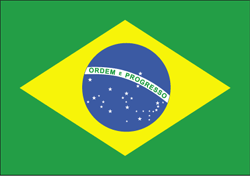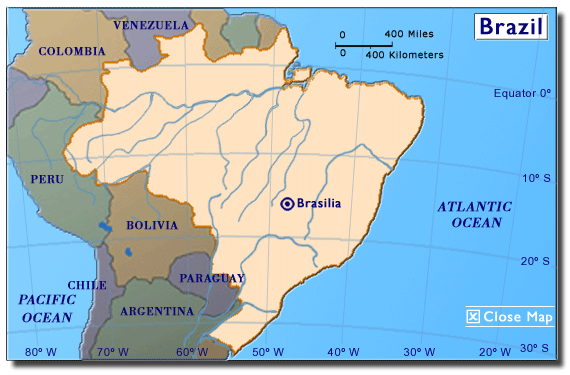Geography
 The Federative Republic of Brazil (Brazil,
2004) is the largest country in South America and the fifth
largest country in the world (Brazilian Embassy in Washington,
2004). It occupies 3,286,470 square miles (8,511,965 sq.
kilometers), nearly half of the total area of the South American
continent. It is only slightly smaller than the US. Besides
the Atlantic Ocean, along which it has a 4,578-mile (7,367
km) coastline, Brazil shares borders with Argentina, Bolivia,
Colombia, French Guyana, Guyana, Paraguay, Peru, Suriname,
Uruguay and Venezuela, all of which are Spanish-speaking nations.
Brazil is the only Portuguese-speaking
country in South America (Flags of the World, n.d.).
The Federative Republic of Brazil (Brazil,
2004) is the largest country in South America and the fifth
largest country in the world (Brazilian Embassy in Washington,
2004). It occupies 3,286,470 square miles (8,511,965 sq.
kilometers), nearly half of the total area of the South American
continent. It is only slightly smaller than the US. Besides
the Atlantic Ocean, along which it has a 4,578-mile (7,367
km) coastline, Brazil shares borders with Argentina, Bolivia,
Colombia, French Guyana, Guyana, Paraguay, Peru, Suriname,
Uruguay and Venezuela, all of which are Spanish-speaking nations.
Brazil is the only Portuguese-speaking
country in South America (Flags of the World, n.d.).
The Equator crosses Brazil in the far north and the Tropic of
Capricorn crosses through the south near Sao Paolo. Brazil
is almost as wide (2,684 miles) as its length from north to
south (2,731 miles). The six largest cities in Brazil (based
on population) are São Paulo (10.4 million), Rio de Janeiro
(5.8 million), Salvador (2.4 million), Belo Horizonte (2.2 million),
Brasília (2 million) and Recife (1.4 million). Brazil has one
of the largest river systems with eight drainage basins carrying
approximately 20% of the world's fresh water. The most famous
of its rivers is the Amazon
(Nationalgeographic.com, 2004a).

Flora and Fauna
Brazil’s renowned rainforests
(which cover 58% of its land area) contain as many as 3000
species of broadleaf, evergreen trees per square mile (Nationalgeographic.com,
2004b). The lowlands and plains along the eastern coast contain
semi-deciduous trees that shed their leaves in the dry season.
Savannah grasslands interrupted by scrub trees are typical
of the central plains of Brazil. Needle-leafed pinewoods cover
most of the highlands in the south. The Amazon Basin and
the Pantanal Matto-Grossense swamplands in the western central
plains are the two largest ecological reserves in the world.
Brazil is a naturalists’ paradise
(Embassy of Brazil in London, 2005a). The numbers of mammal,
bird, fish and other biological species
(under “Fauna”) are not known: some scientific estimates range
from 800,000 to 5,000,000 in the Amazon basin alone (Embassy
of Brazil—Ottawa n.d.)! There are, for instance, over 1,600
species of birds and 600 species of mammals in Brazil.
Climate
Brazil has five climate
zones ranging from semi-arid to equatorial to highland
tropical (South Travels, n.d.). Ironically, the popular image
of the Amazon as one of hot, stifling weather, is not supported
by the reality: the region’s average annual temperatures range
between 72º F and 79º F. Sixty percent of Brazil’s population
lives in areas that have a temperate climate. Although there
is heavy rain in the upper regions of the Amazon basin and
at the mouth of this great river, most of Brazil has moderate
rainfall, averaging 39 to 59 inches per year. Due to its
location relative to the equator, seasons in Brazil are the
reverse of those in the United States and most of the rain
falls during their summer (December 22 to March 21).
The variations in weather
(U.S. Library of Congress, 1997b) contribute to differences
in lifestyle. The cities of São Paulo, Belo Horizonte, and
Brasília enjoy moderate temperatures despite being close to
the equator because they are at higher elevations (U.S. Library
of Congress, 1997b). Rio de Janeiro, Recife, and Salvador
have warm climates because of their coastal locations. In
the south, the climate is considered subtropical. The temperature
can drop below freezing in winter.

History
Brazil has no written history
(History of Brazil, 2004) prior to the arrival of European
explorers in the early sixteenth century (Meade, 2003) .
However, it is estimated that seven-million
indigenous people (Geographia, 2003) inhabited the land
when the first Portuguese
(Geographia, 2003) expedition, headed by Pedro
Álvares Cabral (Doyle, 2004), arrived in Brazil on April
22, 1500 (Boxer, 1991).
The colonization of Brazil by the Portuguese lasted until
1882, when Brazil demanded independence from Portugal (Albuquerque,
Guedes, & Lombardi, 1990). The insurrection was led by
Dom Pedro I
(Pedro I of Brazil, 2005) the elder son of King D. João VI
of Portugal, who went on to proclaim himself Emperor of Brazil.
Faced with widespread opposition to his rule, he abdicated
the throne in 1831 to his son, Dom Pedro
II (Pedro II of Brazil, 2005) and returned to Portugal
(Burns, 1993) . Despite his efforts to industrialize Brazil
and abolish slavery, Brazilians rejected his rule as well,
and he was deposed in November, 1889 by Manuel
Deodoro da Fonseca who became the first President of the
Republic of Brazil (Deodoro de Fonesca, 2004).
Brazil’s journey towards democracy has been challenging at
times (Silva & Malferrari, 2001). Brazilians have experienced
long periods of authoritarian military regime and shorter
periods of democratic administration (Schneider, 1996) . A
civilian government, established in 1985 under President José
Sarney, ratified a democratic constitution (List of Presidents
of Brazil, 2004).
In 1988, a federal
constitution (Constitution Of The Federative Republic
Of Brazil, 1988) was adopted, and the establishment of a democratic
multi-party political system. This brought social stability
and economic progress to Brazil (Cardoso, 2002) . The current
President of Brazil is Luiz
Inácio Lula da Silva , described as a left-wing politician
despite his centrist policies (Luiz Inácio Lula da Silva 2004).
He was elected by 61.2% of the vote during the election held
in 2002.

Political Organization
 Brazil
is divided into twenty-seven administrative regions, encompassing
twenty-six states and one federal district in which the capital (Brasília,
2004), Brasília
(Areal, n.d.), is located. The federal
government is comprised of the Executive, Legislative
and Judicial branches (Politics of Brazil, 2004). The President,
who is the Chief of State and the Head of the Government,
leads the Executive branch. The President and Vice-President
run on the same ticket and are elected by popular vote for
a term of four years. They are limited to serving for two
terms. Brazil
is divided into twenty-seven administrative regions, encompassing
twenty-six states and one federal district in which the capital (Brasília,
2004), Brasília
(Areal, n.d.), is located. The federal
government is comprised of the Executive, Legislative
and Judicial branches (Politics of Brazil, 2004). The President,
who is the Chief of State and the Head of the Government,
leads the Executive branch. The President and Vice-President
run on the same ticket and are elected by popular vote for
a term of four years. They are limited to serving for two
terms.
The Legislature or National Congress is a bicameral body
comprised of the Senate (3 senators for each administrative
region elected by popular vote with staggered 8-year terms)
and a Chamber of Deputies (513 elected to four-year terms
by proportional representation).
Federal, state and municipal court systems make up the judiciary branch
of the government (U.S. Library of Congress, 1997d). The
1988 Constitution established the Federal Supreme Court. The
Supreme Court has the power of constitutional review without
requiring matters to be reached through appeal and can also
issue warrants of injunction to ensure constitutional rights
that are not protected by specific legislation. The 11 judges
to the Federal Supreme Court are appointed for life by the
President and are subject to approval by the Senate.

Economy
Brazil’s economy
is the ninth largest in the world (Economy of Brazil, 2004).
According to the World
Bank (2005), Brazil’s Gross Domestic Product (GDP) in
2003 was US$492.3 billion. Brazil’s economy is expanding into
world markets with well-developed agricultural, mining, manufacturing,
and service sectors. The formation in 1995 of a customs union
and a partial free-trade zone, known as the Southern
Common Market (MERCOSUR) has provided a lucrative market
at its doorstep (Brazilian Embassy in Washington, 2004d).
The official currency is the Real
(Real, 2004).
Brazil has an abundance of natural resources in terms of
agricultural
productivity (U. S. Library of Congress, 1997f) and mineral deposits
(U. S. Library of Congress, 1997g). Brazil is the largest
exporter of coffee in the world. It is also among the largest
producers of soybeans,
corn, grains, citrus fruits, Brazil nuts and cashew nuts
(Embassy of Brazil—Ottawa, n.d.a.).
There has been significant expansion in the commercial production
of oranges
and beef (Embassy of Brazil—Ottawa, n.d.a.). It has the
world’s sixth largest deposit of iron ore as well as among
the largest reserves of bauxite, nickel, potassium, phosphates,
and tungsten. It also has significant reserves of precious
metals and is one of the five largest producers of precious
gems such as diamonds, emeralds and aquamarines in the
world (Embassy of Brazil—Ottawa, n.d.c.).
Industry accounts for approximately 21%
of Brazil’s GDP in 2002 (The World Bank Group, 2004). Major
industries
(besides those based on agricultural raw materials) include
cement, chemicals, motor vehicles and other machinery, textiles
and shoes (Economy of Brazil, 2004).
The existence of so many rivers has enabled Brazil to generate
92% of its energy requirements from hydroelectricity
(Embassy of Brazil—Ottawa, n.d.b.). It is significant to
note that much of its potential remains presently untapped.
Brazilians may argue that they pioneered air flight four
years before the Wright brothers in the United States (Impacto,
Influencia, Cambio, n.d.)! Be that as it may, the United
States is one of the largest purchasers of Embraer designed
and manufactured aircraft.
Perhaps the most surprising fact about the Brazilian economy
is that of the dramatic rise in the services sector, which
accounted for approximately 73%
of its GDP in 2002 (The World Bank Group, 2004). Banking
and financial services make up the bulk of this sector of
the economy.
|

